The quadrennial Copa América tournament has always been an exciting event in the football calendar, with it constantly attracting swathes of football fans from around the world and giving them an opportunity to witness some of the best players currently active as they lock horns in a bid to secure continental honours.
In January 2023, the tournament was elevated to another level, with CONMEBOL and CONCACAF (the governing bodies of South America and North and Central America and the Caribbean, respectively) signing an agreement that would see six of the latter’s member nations also take part in the 2024 tournament and that saw the USA selected as hosts.
However, that should not detract from the belief among many that the winners will come from the tournament’s homeland, with defending champions and reigning world champions Argentina the current favourites and in a rich vein of form, having incurred just one loss since their surprise defeat to Saudi Arabia at the beginning of their 2022 World Cup campaign.
There is no doubt that Lionel Scaloni’s side are a side to beat at this moment in time and a team that no one is relishing coming up against, and this tactical analysis will take a closer look at why so many are backing them to go all the way.
Argentina Predicted Starting XI
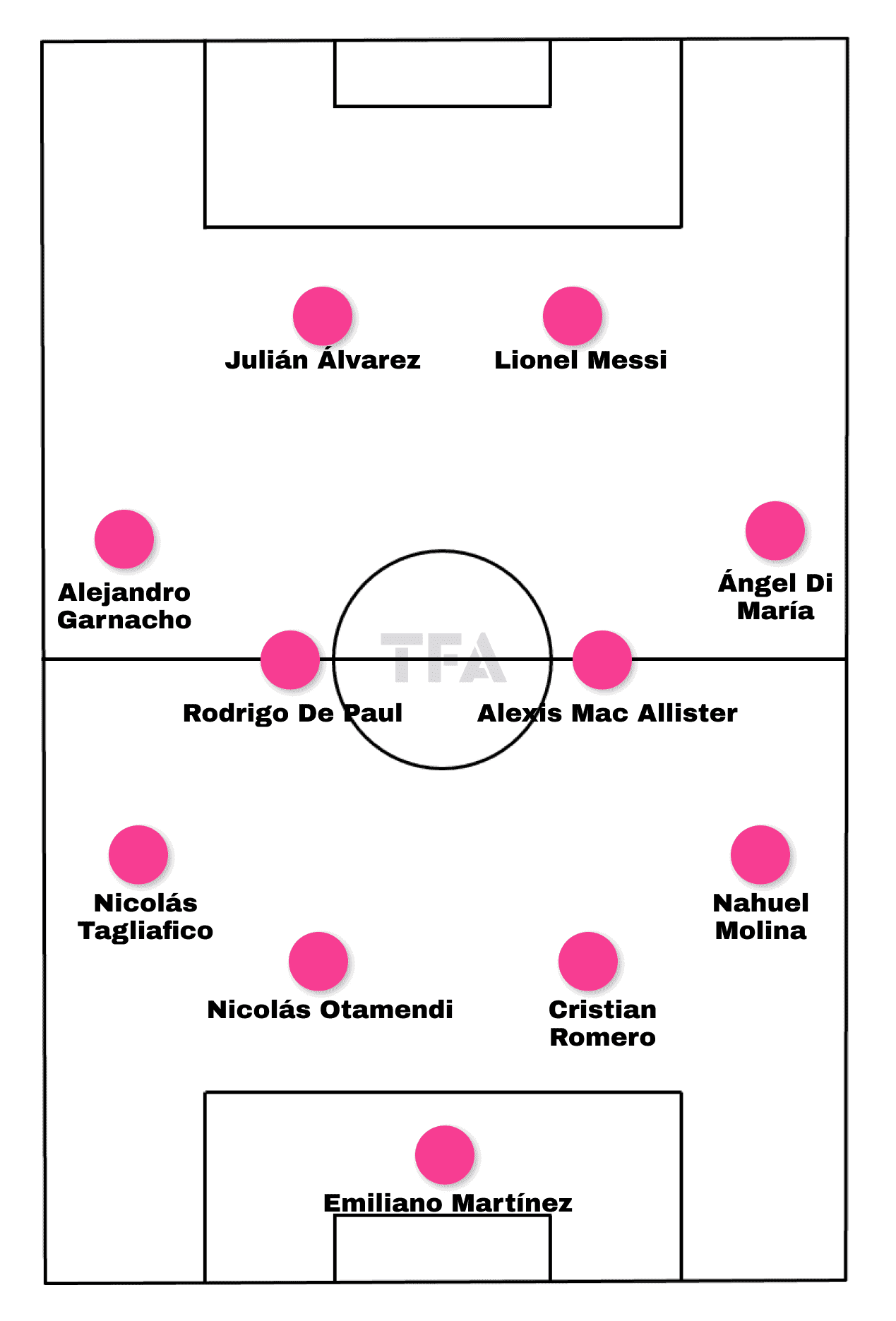
When it comes to Argentina’s preferred shape, what is abundantly clear is their preference for structural balance over style, with the 4-4-2 formation their predominant choice and one that is not as common to see in the modern game due to the positional rigidity that it is often associated with it.
However, Argentina are not a team who rely simply on older methods to win games, with there also being a significant number of current trends present in their play.
For example, they like to play out from the back and to progress the ball through the thirds whenever there is an opportunity for them to do so, and it is for that reason that the duo of Nahuel Molina and Nicolás Tagliafico suit their tactical desires well, with both having a tendency to get up the field and to facilitate quick passing sequences around the pitch.
Playing with this mentality does lead to an inherent amount of risk with regards to the centre-backs being left too exposed inside their own third, but Argentina counter that by ensuring that they have a partnership at the back that is strong and capable of holding their own whenever under pressure.
Both Tottenham Hotspur’s Cristian Romero and Benfica’s former Manchester City player Nicolás Otamendi have constantly shown themselves to have those qualities in their skillsets as their careers have gone on.
So it is likely that Scaloni will once again trust them to shield Aston Villa goalkeeper Emiliano Martínez and to give the rest of the team confidence to implement the rest of their game plan.
With the full-backs being so attack-minded, the two wingers need to be players who can cut inside the pitch in order to create overloads in central areas, and it is for that reason that Ángel Di María and Manchester United’s Alejandro Garnacho seem like the most logical players to start in those roles.
The former has always been capable of operating in central areas and is a versatile attacking player who can create as well as score goals, whilst the latter has provided his side with some positivity through his sharp changes of direction with the ball at his feet in what has otherwise been another disappointing campaign.
Having them moving infield frees up the central midfielders to focus less on creating and scoring goals (though it is a bonus if they do bring that to the table) and instead prioritising moving the ball around the field and connecting it’s two halves together.
A partnership of Liverpool’s Alexis Mac Allister and Chelsea’s Enzo Fernández certainly provides that, with the former being one of the Premier League’s more underrated players during 2023/24, whilst the latter might have had another underwhelming campaign, but his abilities on the ball cannot be doubted when he is at his best.
At the top of the field, the double threat of Lionel Messi and Julián Álvarez gives Argentina more layers whenever they are creating goalscoring opportunities as well as giving them two ways of scoring goals, with both being capable of leading the line but also known for their ability to drop into pockets of space and to further connect the team together.
Therefore, they complement each other well and have a partnership that has proven to be fruitful for their nation on many occasions.
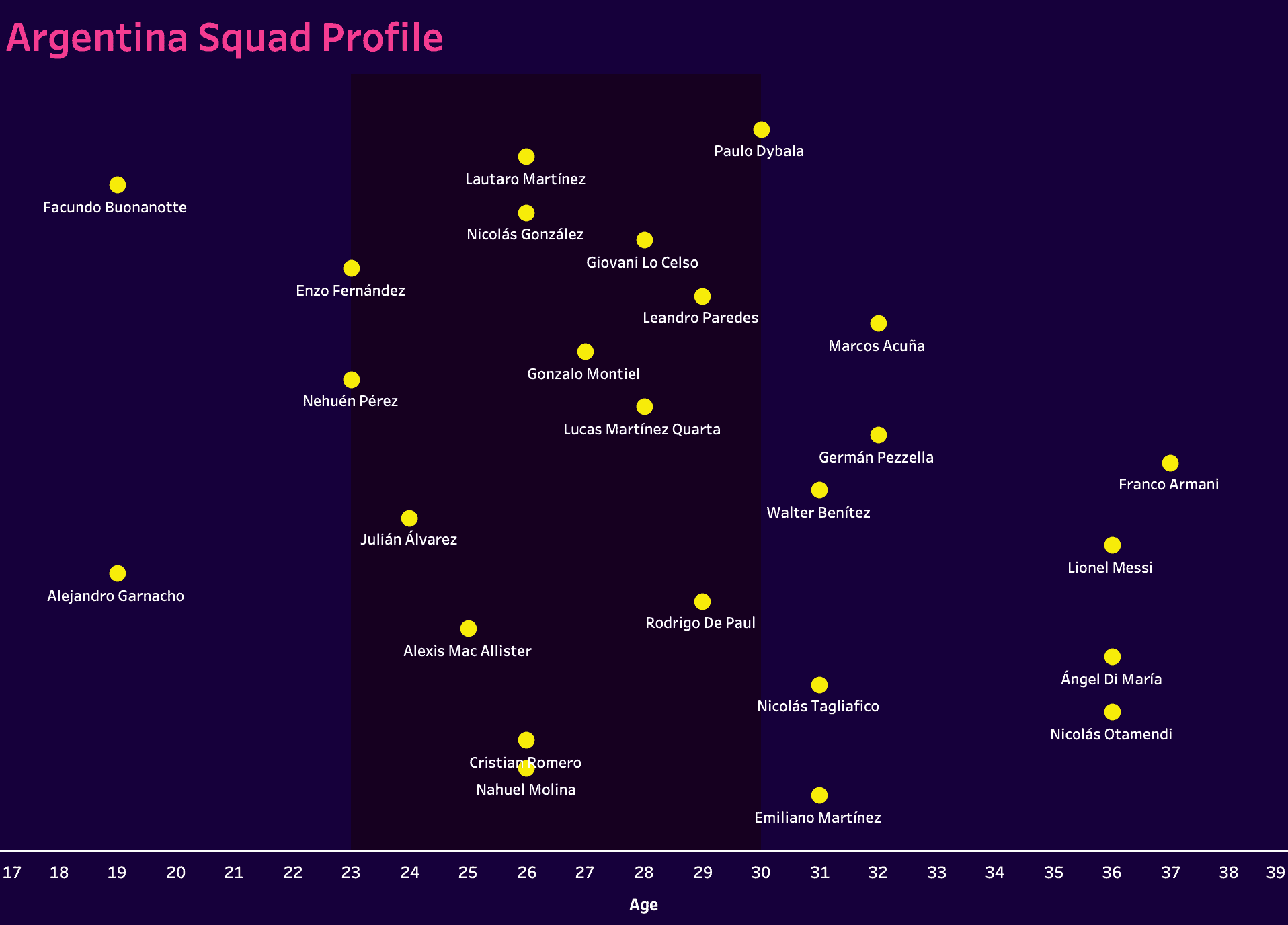
Of course, any team with a desire to be successful needs to have good depth in its squad, too.
Those who win trophies are always the sides that can bring different types of players onto the field from the bench and who can change games in their favour whenever things aren’t necessarily going their way.
Scaloni’s belief in this is highlighted in this graphic by the spread of ages that Argentina are likely to have in their final Copa América squad.
He largely favours players with established reputations in the game and those with experience but also looks to hand opportunities to talented youngsters.
There is so much reliance on players who are mostly over the age of 23, which could be a result of the expectation that fans have of Argentina to achieve honours due to their history as world-beaters.
It is perhaps felt that those either in the middle of or nearing the end of their careers understand that better.
However, tournaments are always about bringing the next generation on and giving them a taste of what is to come in the future.
So, any coach needs to get the balance right between having experienced players who know how to win games and younger options who are still developing if they are to maintain a constant stream of success.
Attacking Phase
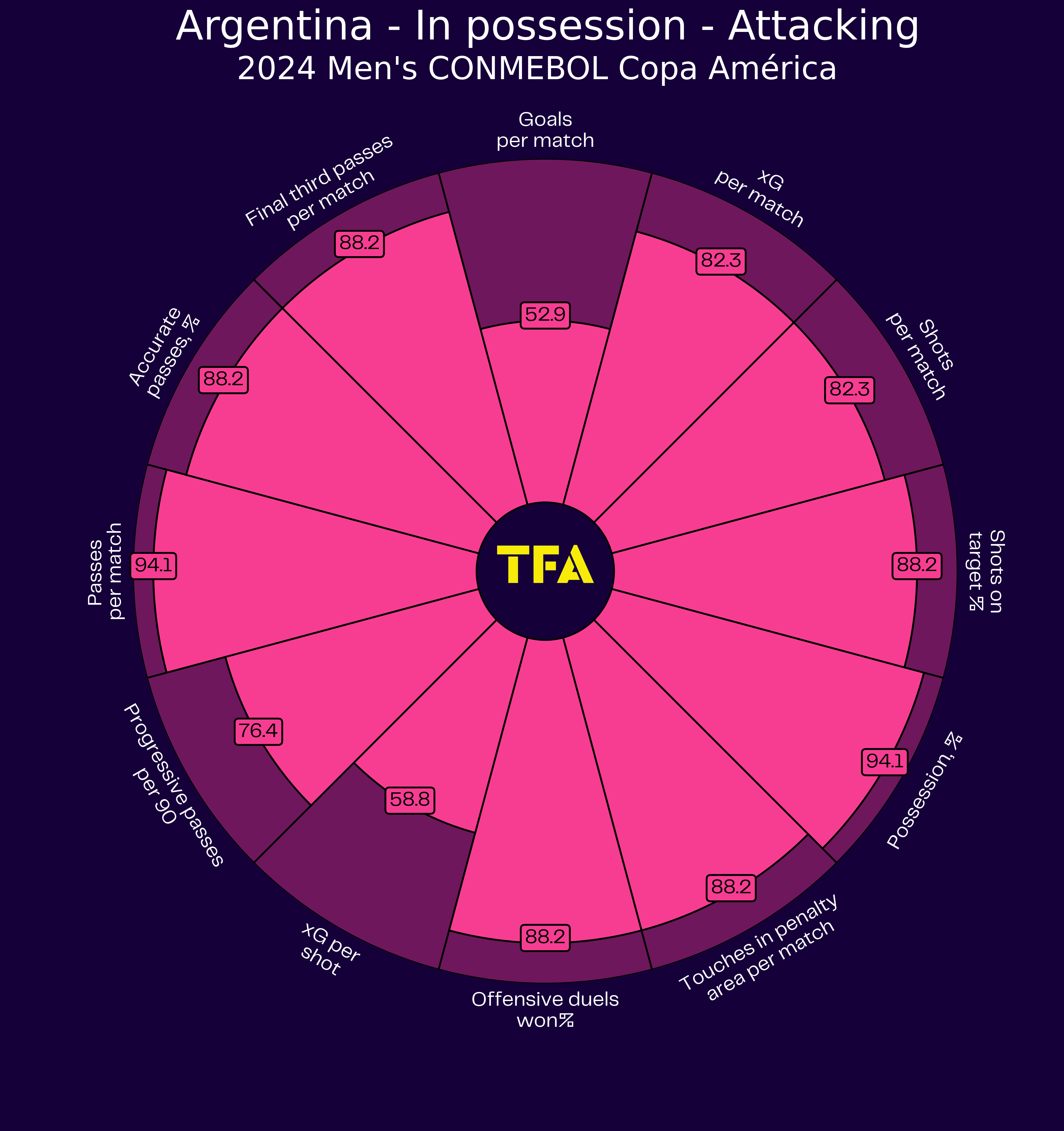
Regardless of whether fans believe that Argentina’s age split is diverse enough, everyone can agree that they are getting results on the field.
Their attacking play, in particular, has been really strong of late, and this graphic indicates that through their high percentile rankings in a number of different statistical areas.
However, there are a few things that really stand out and which require further analysis, not least of which is that Scaloni’s side don’t compare too favourably to others in the tournament when it comes to goals scored per game.
Instead, they sit marginally above the median in percentile terms for this statistic, and what can be drawn from this is that their threat comes through their ability to consistently score the one or two goals that they need to beat their opponents rather than from them racking up huge goal margins.
In short, they are clinical and productive but are not greedy, and they know when it is right to focus on consolidating what they have rather than on pushing for more.
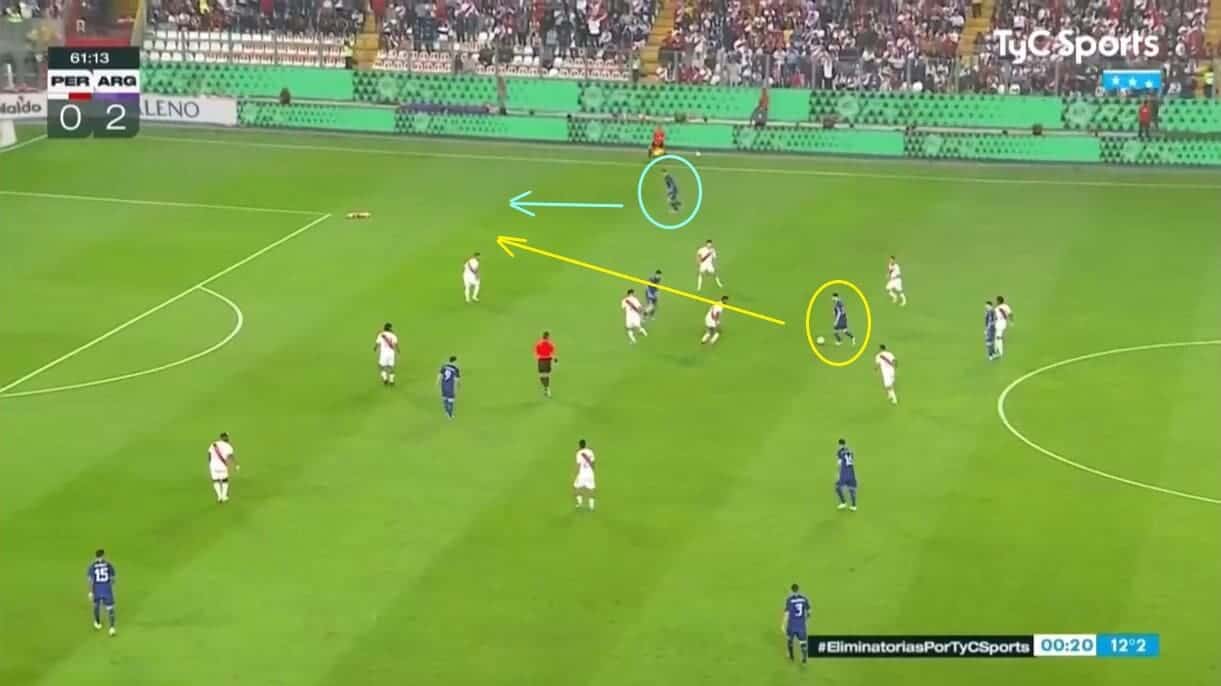
What makes Argentina such a difficult team to keep out is their ability to play expansively.
It is abundantly clear when watching them that so much of what they do well comes down to maintaining their width and stretching their opponents out in any way that they can.
As highlighted previously in the scout report, this is a role that normally falls on the full-backs, with it already mentioned that a critical part of Argentina’s tactics is about them getting up the field whenever the team is in possession and on creating natural passing options for the ball to travel through in a progressive manner.
In this case, Lucas Martínez Quarta has continued his run into the gap that he found behind Peru’s defensive line and has given Messi the chance to send the ball forward here and into an area from which Argentina can fashion a shot on goal.
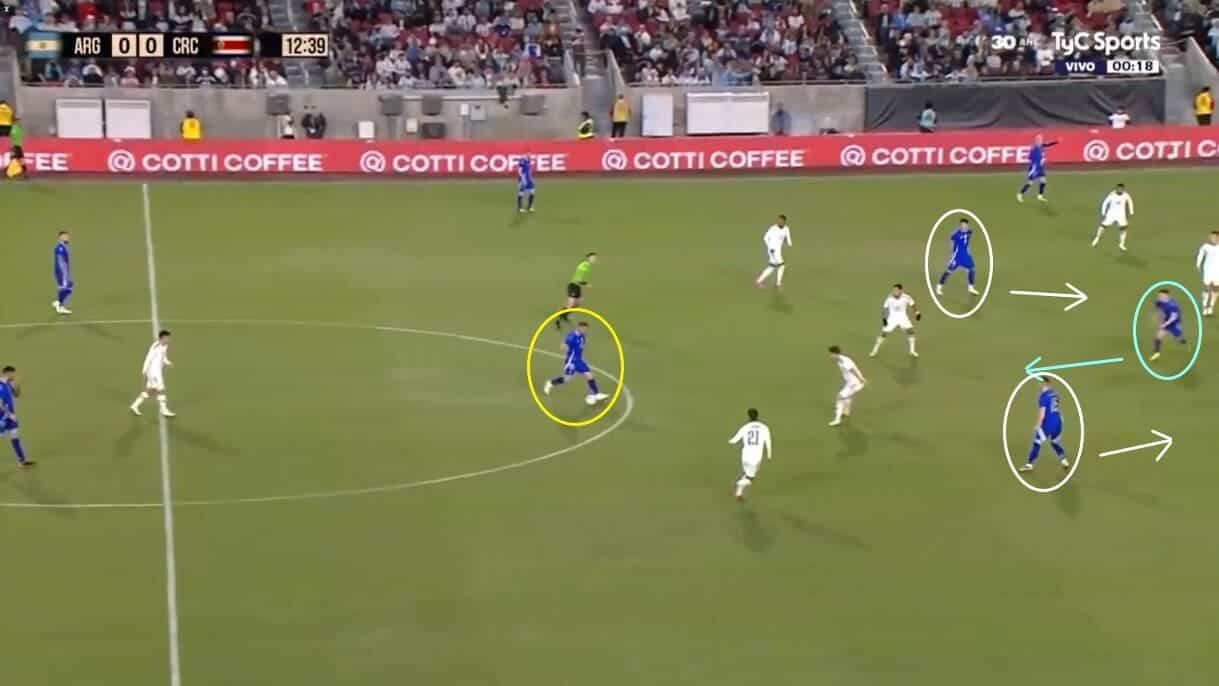
Whilst this works well when there is space available for the full-backs to attack into, there have been times when opponents have looked to sit back in a low block against them in order to remove that option from their game plan.
As a result, Argentina have, at times needed to adapt their offensive play in order to find other ways of creating chances.
Yet, this has never phased them, so it also needs to be factored into the equation when looking at why they have been in such a fine run of form.
In this case, Costa Rica have looked to set up in just such a defensive manner and are looking to keep as many of their players behind the ball as they can, and Argentina have, therefore, needed to get creative with how they access spaces ahead of them.
To break this low block down, Argentina looked to draw opponents out of line and thus create gaps for others to then run through, and that was instigated here by Álvarez moving towards Mac Allister, who has the ball and tempting the Costa Rican defenders into following him.
It was a temptation that the latter failed to ignore on this occasion, with Julio Cascante opting to stay with the Manchester City striker rather than holding his position in the back line, and that then gave Fernández and Tottenham Hotspur’s Giovani Lo Celso the chance to make the opposite movement to Álvarez and to give Argentina a way of moving the ball into a dangerous position.
When looking at why Argentina have scored three times in their two matches in 2024 so far and averaged 2.1 per outing in the entirety of last year, it is not hard to see how important this ability to have different ways of breaking opponents down has been to their strong run of results.
It can be expected that when the Copa América action gets underway, Scaloni will continue to ensure that his side has a plan to deal with every opponent that they come across as they aim to successfully defend their crown.
Defensive Phase
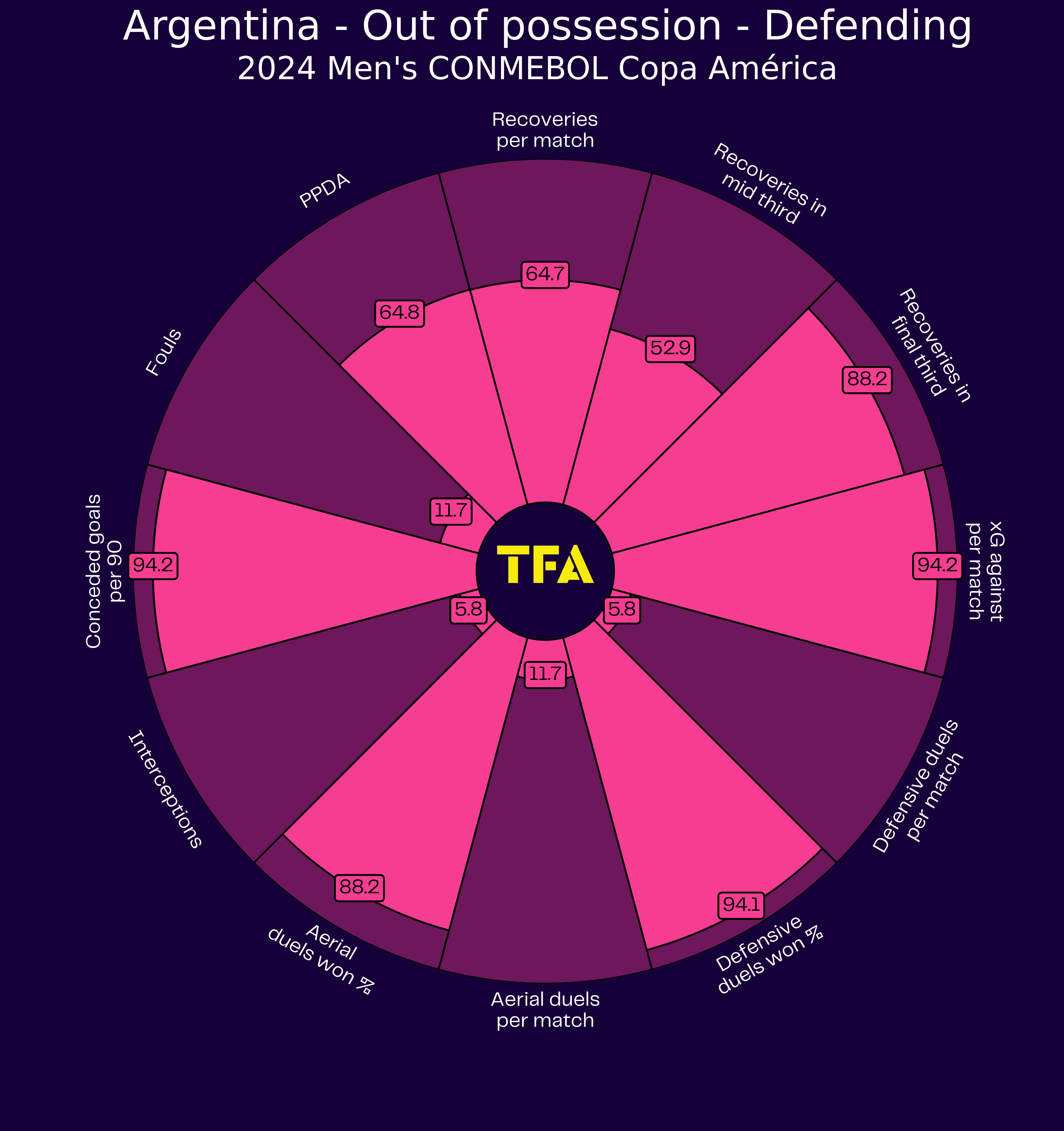
The theme of Argentina keeping things simple around the field and never pushing for too much continues when looking at their defensive play, with it clear to see that they don’t compete in many defensive or aerial duels per game but that they win a high percentage of those that they do engage in.
As a result of that, they rank favourably for goals conceded per game in percentile terms (with their high statistical position on this graphic showing how watertight they are when compared to other teams), and that again highlights how defending with quality and simplicity are key in them winning matches without needing to score too many goals in each game and so not needing to push too hard to gain wins.
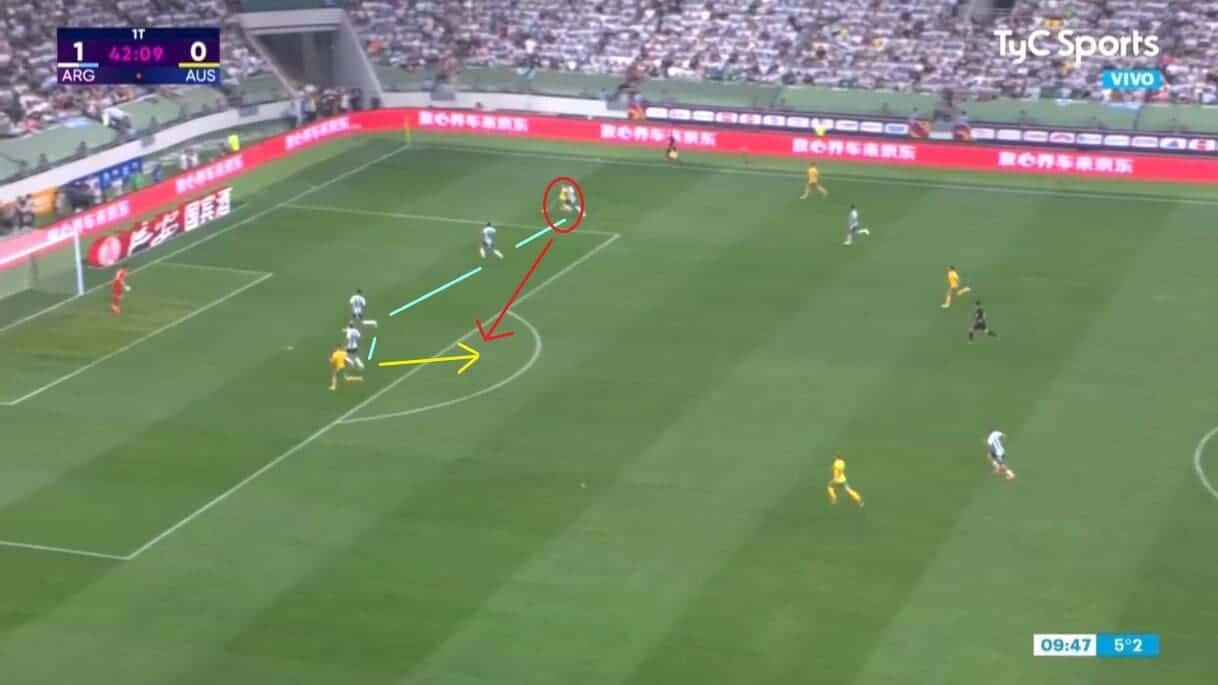
This ability to be solid at the back is mainly down to the way that Argentina keep one of their full-backs in a deeper position at all times in order to ensure that they never leave themselves too susceptible to counterattacks, with it clear to see here how Australia have moved the ball up the field quickly and have got behind the majority of the Argentinian players before they have been able to react and to get back into position.
As a result, the onus is now on the three players furthest back to keep the ball out of their goal, and the fact that they have set up in a compact manner is one of the ways in which they look to execute that, with their attitude being to keep opponents in wider positions where it is always trickier to shoot at goal with a high degree of accuracy.
In this case, Hearts right-back Nathaniel Atkinson has the ball, and it can be seen how his angles through which he can send it into the middle are tighter than he would have liked, with the positioning of the Argentinian defensive line meaning that his only options are to pass it into the constantly decreasing corridor between them and the goalkeeper or to pull the ball back for a teammate to run onto in front of the defenders.
He opted for the latter as things turned out here, and that then allowed Molina, who is on the near side of that back three here, to move towards the ball and to clear his lines.
Therefore, what is evident is that, like with their attacking play, Argentina operate with clarity and cohesion and each player knows what to do regardless of what situation they find themselves in, and that is one reason that they have conceded just 0.5 goals per game this year and let in 0.2 per match throughout the entirety of 2023.
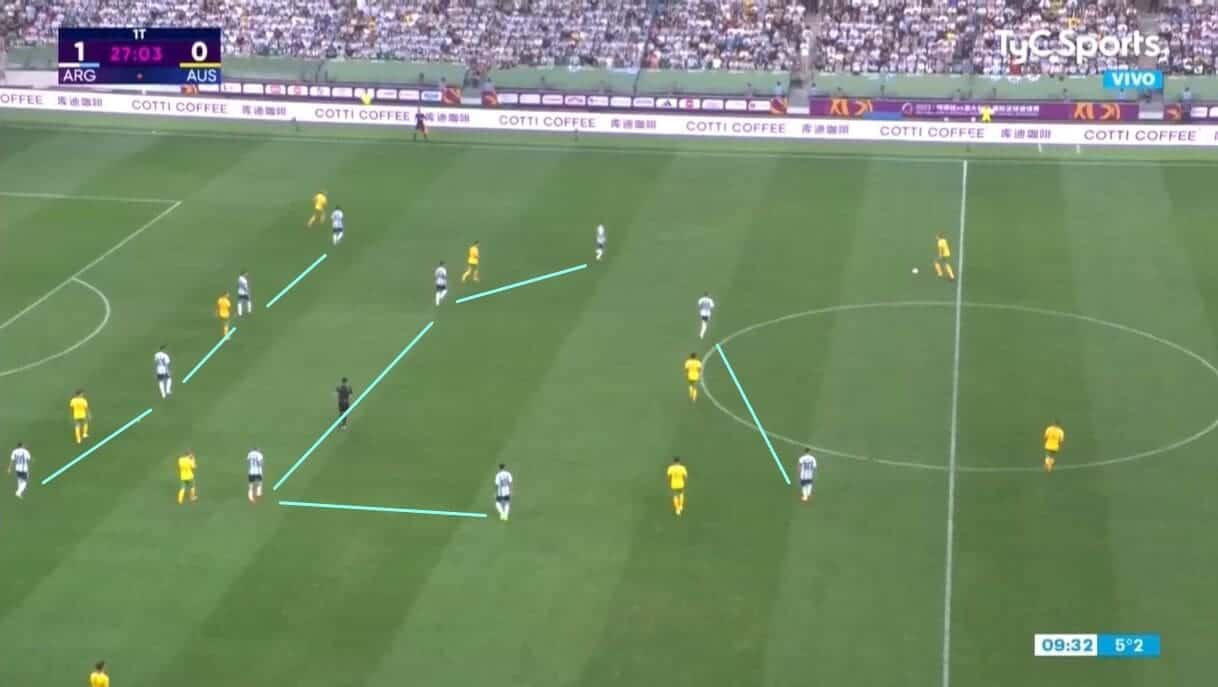
That is not to say that they are entirely watertight, though, and there have been moments when they have invited pressure unnecessarily and have made it too easy for their opponents to play through them.
In this situation, from the same match against Australia, Scaloni’s side have players behind the ball, and their 4-4-2 shape is present, with the focus on defending the central spaces once again clear to see as they have not looked to push too far out towards the wings.
However, the thing to note here is the gaps that are available between each of their lines, and that alone means that Australia have an opportunity to progress the ball up the field and to use their own passing options to transfer it into a dangerous area of the field.
On this occasion, they did manage to get a shot away at goal through striker Mitchell Duke only a couple of phases after this moment, and so that highlights how Argentina are not completely infallible and that there are times when they do need to be tighter to each other and therefore harder to break down.
Argentina Transitions
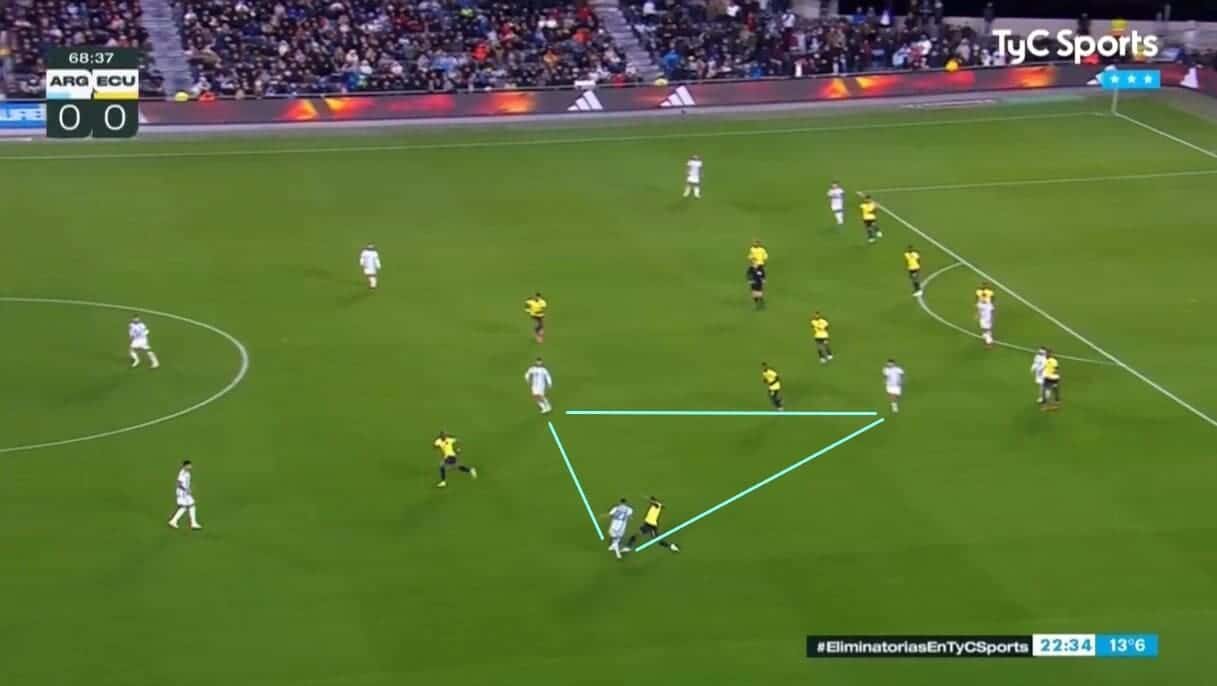
As might have become evident as the scout report has gone on, transitions play a vital role in Argentina’s ability to connect the different areas of their team together.
The rotations present when they have the ball create the passing routes for it to travel through and ensure that they are never too conservative whenever there isn’t a need for it.
Getting this aspect of their play right is down to not only them having the right balance but also the way that their players continually move around the field, with it mentioned at the beginning of the analysis that Scaloni’s side have a formation that many don’t like much anymore but that they then implement current ideas in order to make it fit for purpose in the modern game.
The tactic that is clear to see here is the way that they create triangles around the field, and it is this that has made them so difficult to win the ball from whenever they have been in their full rhythm, with them registering a highly impressive passing accuracy of 90.6% this year and 89.7% for 2023.
In this case, it is the trio of Mac Allister, Rodrigo de Paul and Molina who are working together to play through the Ecuador players in their vicinity, and their ability to keep the ball here led to Messi getting a shot away at goal only a few seconds afterwards.
With Argentina averaging 73.91% possession so far this year and 62.71% in the last one, these coordinated sequences of play have been vital in helping them keep control of games and ensure that they have the best possible chance of winning them.
This is another reason that they will prove to be tough opposition once the tournament action gets underway.
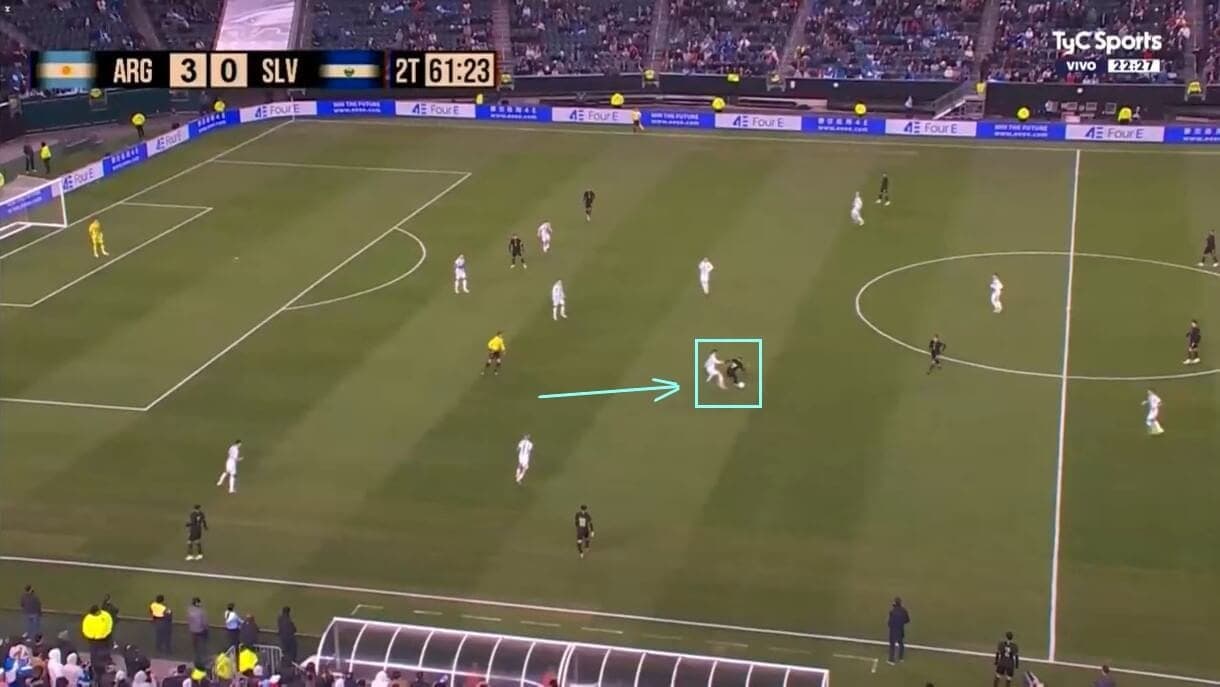
As soon as Argentina lose the ball, their attention turns in an instant towards tracking back and setting up in their starting shape.
However, as has been looked at already in the analysis, the speed of the opposing attack means that this is not always possible, and so what is also common to see is that they will look to counterpress individual opponents in a bid to cut those counterattacks out before they have had time to materialise.
The effect is shown here as Molina gets tight to El Salvador’s Jairo Henríquez, with the latter being closed down before he has had a chance to control the ball and plan his next move.
This highlights Argentina’s determination to protect their goal at all costs and each player’s instinct to ensure that they prevent opponents from having any opportunities to test their luck in front of goal.
In this case, Molina’s intervention provided Argentina with the time needed to get more players back behind the ball.
This meant that the gaps that had previously existed were securely plugged, and El Salvador was unable to turn their chance into anything more than that.
Forwards
It has already been mentioned that what makes Argentina such a dangerous side to play against is the ability of their forward duo to drift between different positions and to ensure that there are always routes for the ball to travel through between the central and final thirds, and that is something that both Messi and Álvarez constantly conform to.
However, there is also a need for teams to have different types of players available to them, which leads back to the variety that Scaloni likes to have in his team.
In this case, though, it is not a variety of ages but of profiles, with their main alternative at the top of the field likely to be Lautaro Martínez, who is much more of an out-and-out goalscorer and who offers something different to both Messi and Álvarez.
The other player who could be included is Paulo Dybala, though how much game time he gets is difficult to predict due to his recent injury problems.
Therefore, he might come in as an emergency player or be left out altogether, and his position and role in the team will only become clear once Scaloni formally announces who will be on the plane to the USA.
Argentina Midfielders
When looking at the midfield options, there is again a need for variety.
Both Fernández and Mac Allister tend to sit deeper on the field and focus more on passing, so there is a risk that a gap between them and the forward emerges that opponents can use to their advantage.
Should that become an issue, the likely inclusion of both Leandro Paredes and Lo Celso will provide a more attacking presence and allow them to frequent slightly higher positions on the field.
It might well be that there is some rotation in the central midfield roles as Scaloni looks to find the best combinations for each individual match.
On the wings, there doesn’t appear to be as great a need for variety.
Instead, both Facundo Buonanotte (backed to be an emerging player to watch in the tournament) and Nicolás González are not too different in profile to Di María and Garnacho, with them offering an ability to cut inside and to create the same central overloads that were mentioned previously in the scout report.
So, it is likely that the responsibilities attributed to the wing positions do not change as the tournament goes on.
Defenders
In defence, it has already been highlighted that Argentina need central defenders who are confident when working on their own and who are capable of doing multiple things at once, with there always being a strong chance that teams could counterattack at speed or could play through their ranks without being hindered too greatly.
As a result, both Germán Pezzella and Nehuén Pérez are much of a likeness to both Romero and Otamendi, and so should be able to slot in without too much disruption, although it seems unlikely that they will start if the latter two are fit and available.
At full-back, the key thing to note is that those players have to be able to defend and attack with equal ability, such is the desire for them to be an additional attacking outlet or a third centre-back depending on the whereabouts of the ball, and that is another aspect of Argentina’s play that is non-negotiable.
As a result, all three players who offer back-up options to Molina and Tagliafico have shown themselves to be capable players in both aspects of the game.
Gonzalo Montiel and Marcos Acuña have demonstrated their ability to get up the field and to track back constantly for Nottingham Forest and Sevilla, respectively, this season, while it has already been highlighted what Martínez Quarta offers around the field.
Argentina Key Player
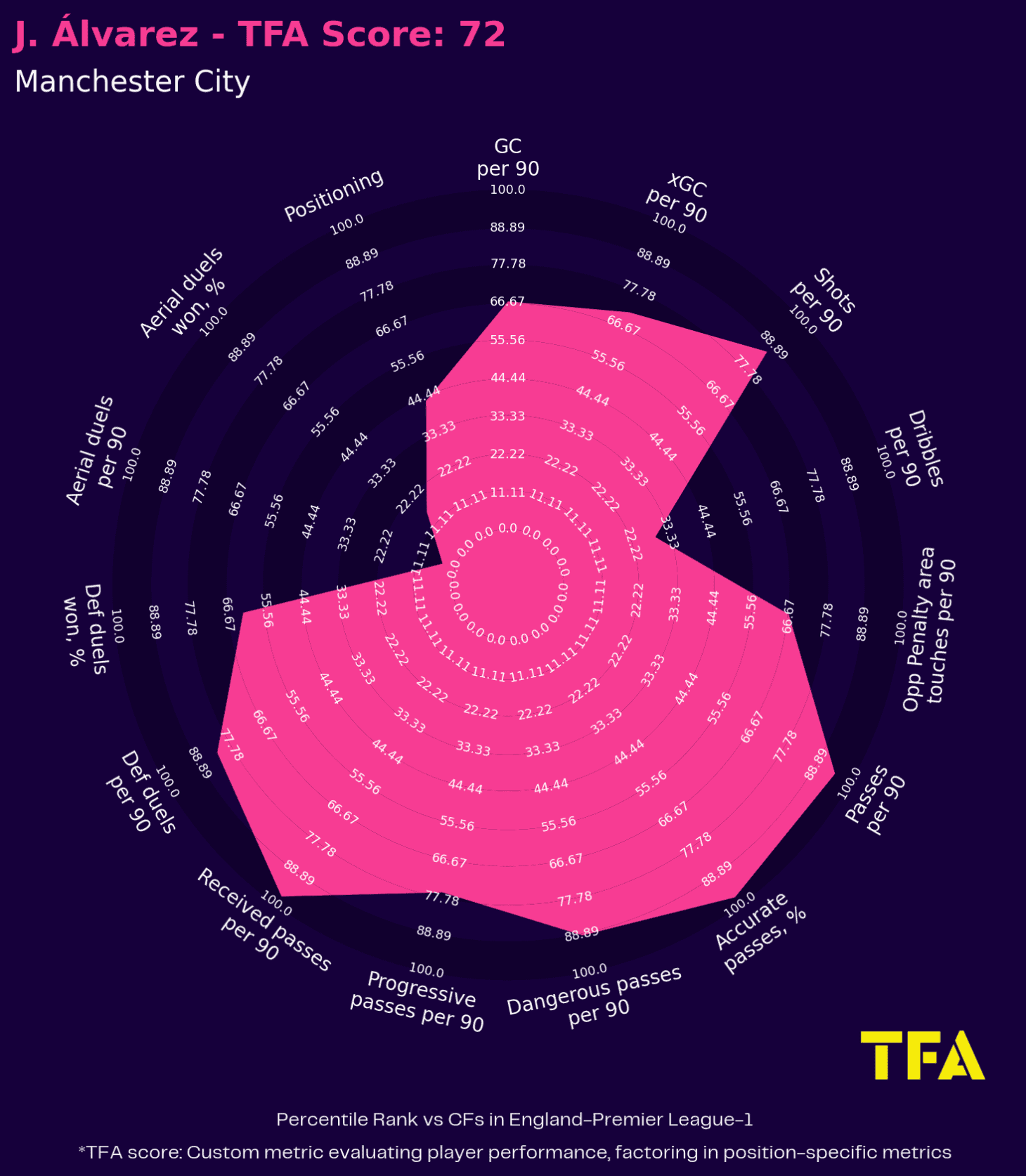
It might be imagined that Messi is the obvious player to name as the one who could make the difference for Argentina on the day, and it is true that he is being backed to have another successful tournament on an individual level; such has been the strength of his performances for Inter Miami in the MLS this year.
However, it is actually his strike partner, Álvarez, that needs to be highlighted here, with the variety of things he offers around the field so vast that he could significantly impact Argentina’s performances.
His goal threat has been evident for so long, and he undoubtedly made the difference for them during their triumphant World Cup run two years ago, as is shown by his high ranking for shots taken per game in percentile terms in this graphic, but what is also clear is that his other better-performing statistics are his received passes per game, passes made per game and his overall passing accuracy, with him in the top band for all three.
Therefore, he can be backed to get involved in transitions and to create chances, too, as has been prominent during his time at Manchester City, and it could well be that he becomes a key focal point for his side whenever they are on the attack.
Argentina Tournament Prediction
Whilst this scout report has discussed tactics, player combinations, and game plans extensively, all that ultimately matters in tournament football is winning matches.
Teams compete for points initially as the group stages take place but then seek simply to get through each round and navigate the obstacles that they encounter.
For Argentina, with them in a group that also includes Peru, Chile, and Canada, progression will not be easy, but it is widely expected, and it would be a shock not to see them top the standings after facing all three.
It will be after those matches that fans and the media will be able to get a better idea of what shape they are in, but the expectation is that they will go all the way and that they will be the ones to lift the trophy into the Miami night sky in mid-July, adding another entry to their ever-increasing honours list.

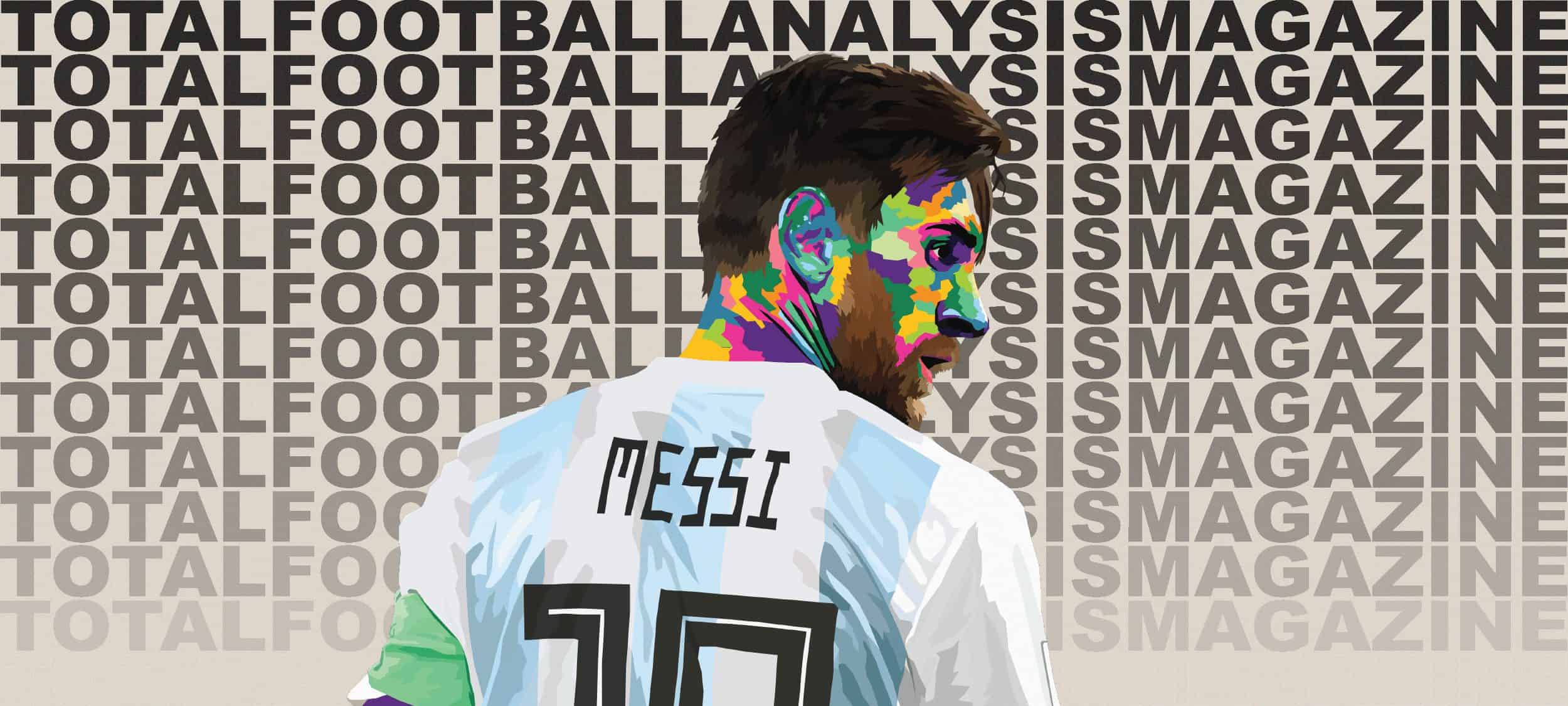



Comments